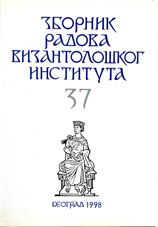О ликовима старозаветних првосвештеника у византијском зидном сликарству с краја ХIII века
Оn the lmages of Old Testament Аrсhрriеsts in Вуzаntinе Frеsсо-Раinting at the End of the 13 th Сеnturу
Author(s): Dragan VojvodićSubject(s): Fine Arts / Performing Arts
Published by: Vizantološki institut SANU
Summary/Abstract: In this study, we focused attention on the new significance and new meanings that the images of Old Testament archpriests acquired at the end of the 13th century in the programs of several Orthodox churches in the Balkans: the Virgin Peribleptos in Ohrid, St Achillius in Arilje, St Nicholas in Prilep and Protaton on Mt Athos. It has been shown first that in these churches the figures of Old Testament archpriests were given a more prominent place than in older art. A developed and firmly connected line of figures is represented here, and occasionally includes six individuals (Aaron, Moses, Hur, Samuel Melchizedek, Zacharias). This line begins to dominate considerably broader thematic wholes into which it is incorporated. The development of the lines of archpriests has been achieved through the introduction of several new personages who, according to the Biblical texts, only had an indirect connection with the vocation of a priest, or no connection at all, but in the Orthodox religious practice they were singled out as God's ministers equal to Aaron. The fact that at the end of the 13th century a distinguished prophet, like Moses, was included among the archpriests in Byzantine wall-painting and represented for the first time in the archpriest's vestment, is of tremendous significance. In Byzantine monumental art, the appearance of this new iconography of the figure of Moses is contemporaneous with the appearance of the developed representation of the Tabernacle in which Moses, clad as an archpriest, officiating alongside Aaron. The increased number of the figures of Old Testament archpriests and their importance in painting programs brought about changes in their iconography. From the close of the 13th century onwards, archpriests were almost regularly painted with recognizable 'personal' attributes in their hands (stamnos and a rod are Aaron's, tablets Moses', a horn is Samuel's, a basket with loaves of bread is Melchizedek's), while in older art they were most often represented with 'general' attributes of priests - a censer and an pyxis. In this period, iconographic epigraphs (initials of the names of the founders of Hebrew tribes) was introduced as an ornament on the cloaks of Biblical archpriests.
Journal: Зборник радова Византолошког института
- Issue Year: 1998
- Issue No: 37
- Page Range: 121-153
- Page Count: 37
- Language: Serbian

